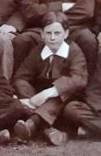
|

|
| Squadron Leader Eric Ralph Carrington HOBSON DSO DFC | |
|
6 Squadron Royal Air Force Date of birth: 12th February 1895 Date of death: 9th April 1938 Died aged 43 Buried at Ramleh War Cemetery |

|
| Eric Ralph Carrington Hobson was born at San Fernando, Trinidad on the 12th of February 1895 the elder son of Leonard Manning Hobson, an attorney-at-law and Mayor of San Fernando , and Dorothy Asygell Williams | |
| News House |
Back